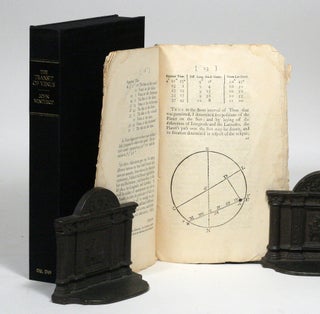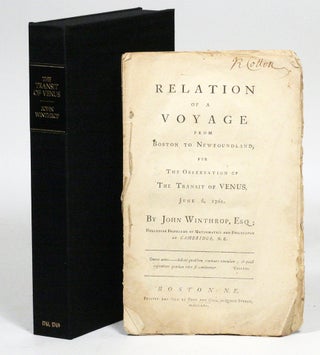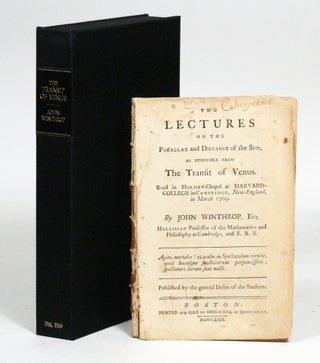Relation of a Voyage from Boston to Newfoundland, for the Observation of the Transit of Venus, June 6, 1761. WITH: Two Lectures on the Parallax and Distance of the Sun, as Deducible from The Transit of Venus
“You’ve seen her [Venus] in the Evening Sky, you’ve wish’d upon her, and now for a short time will she be seen in the Day-light, crossing the Disk of the Sun …. Thro’ our whole gazing-lives, Venus has been a tiny Dot of Light, going through phases like the Moon, ever against the black face of Eternity. But on the day of this Transit, all shall suddenly reverse, — as she is caught, dark, embodied, solid, against the face of the Sun, — a goddess descended from light to Matter. And our Job … is to observe her as she transits the face of the Sun, and write down the Times as she comes and goes ….” -Thomas Pynchon, “Mason and Dixon” (1997)
“[W]hat made this [transit] of June 6, 1761, most of all famous, was a paper of the same learned author [i.e., the Astronomer Royal, Edmond Halley], wherein he explains an important use to be made of it. Some uses of the transits of the inferior planets were obvious. … But Dr. Halley pointed out a new and singular use to be made of the Transit of Venus and to which no other phenomenon in the heavens is near so well adapted. This is in finding the Parallax of the Sun, which is so small that the Astronomers have never been able to discover it with exactness in any other method. If this were once known, the distance of the Sun, and of all the Planets, and of all the Comets, would be known too, and their magnitudes would also be known from their apparent diameters. This would give us a just idea of the vast dimensions of the solar system, and of the mighty globes which compose it.” -John Winthrop, FRS, in the work offered here (1761)
VERY RARE FIRST-HAND ACCOUNT OF THE FIRST PUBLICLY FUNDED AMERICAN SCIENCE EXPEDITION: JOHN WINTHROP’S VOYAGE TO NEWFOUNDLAND TO PARTICIPATE IN THE INTERNATIONAL EFFORT TO TIME THE 1761 TRANSIT OF VENUS AND THUS DETERMINE THE DISTANCE BETWEEN THE EARTH AND THE SUN.
WITH THE RARE FIRST EDITION OF HIS SUBSEQUENT LECTURES ON THE TRANSIT OF VENUS.
Transits of Venus and Their Importance:
By chance, the Sun is about 400 times larger in diameter than the Moon, and about 400 times farther from the Earth. As a result, the two bodies have roughly the same apparent size; and on the rare occasions when the Moon is located directly between the Sun and Earth, the Sun is blotted out, with only its corona visible — thus, a total eclipse. Other objects in the solar system do not have such a precisely calibrated relationship between their size and distance from the Earth, and as a result when they pass between the Earth and the Sun, their passage, when visible at all to earthbound astronomers, appears as a small black dot moving across the Sun’s face. This phenomenon is known as a transit. Since Mercury and Venus are the only two significant celestial objects that pass between the Earth and Sun (setting aside the Moon and the occasional comet), it is only those planets that are observed to transit the Sun.
In 1716 Edmond Halley published a paper in the Philosophical Transactions of the Royal Society of London (written in Latin, then the international language of science, and titled “Methodus singularis qua Solis Parallaxis sive distantia a Terra …”) in which he argued that precise measurements of the timing of a transit of Venus could be used to determine the “solar parallax” — that is, the angle that the Earth would subtend if it could be viewed from the surface of the Sun. The magnitude of the solar parallax could then be used to determine the absolute distance from the Earth to the Sun. At the time, that distance was known only in relative terms, as a fraction or multiple of some other astronomical distance, such as planetary radii, distances between planets, or distances between other planets and the Sun.
“Halley had propounded the revolutionary idea that Venus’s transit could be used as a natural astronomical instrument — almost a celestial yardstick. If several people around the world were simultaneously to watch the entire transit from different places as far apart as possible, he explained, they would each see Venus traversing the sun along a slightly different track — dependent upon the observers’ locations in the northern or the southern hemispheres. Venus’s path would be shorter — or longer — across the sun according to each viewing station. With the help of trigonometry, these different tracks (and the differences in the duration of Venus’s transit) could then be used to calculate the distance between the sun and the earth.” Andrea Wulf, Chasing Venus: The Race to Measure the Heavens (2012), p. 5.
Halley, who had compiled a table of past and expected future occurrences of the transit of Venus, realized that such transits were extremely rare events. “Because the orbits of Venus and earth have different inclinations, Venus usually passes above or below the sun ….” Transits occur in pairs eight years apart, and “[t]he periods between the pairs of transits alternate between 105 and 122 years.” Halley understood that the rarity of such transits increased the importance of careful advance planning of a program for observing the ones that were expected to occur in 1761 and 1769. The next transits after the 1761/1769 pair would not occur until 1874 and 1882, and the two after that would not occur until 2004 and 2012. Wulf, op cit.
Responding to Halley’s proposal, a cooperative international program was organized to observe the 1761 transit from various parts of the world where it would be visible. The sole participant from the British colonies in North America was John Winthrop, whose observations of the transit are reported in the work offered here. (Participants in other parts of the world included the surveyors Charles Mason and Jeremiah Dixon, who would soon become famous for surveying the Mason-Dixon line between Pennsylvania and Maryland, and whose experiences chasing the 1761 transit are recounted in Thomas Pynchon’s novel Mason and Dixon, quoted above.)
John Winthrop:
“John Winthrop was the son of Chief Justice Adam Winthrop of Massachusetts Bay Colony and the great-grandnephew of the first colonial Fellow of the Royal Society.” (Raymond Phineas Stearns, Science in the British Colonies of America (Univ. Ill. Pr. 1970), p. 642.) In 1738, at the age of 23, he was appointed to the Hollis Professorship of Mathematics and Natural Philosophy at Harvard. He held the Chair until his death in 1779. Brooke Hindle, in “The Pursuit of Science in Revolutionary America: 1735-1789” (Univ. N. Car. Press 1956) refers to him as “Colonial Harvard’s finest flower in the field of science. … His writings were distinguished for their clarity and sweep as well as for their occasional flashes of brilliant insight. Alone among the teachers, Winthrop was elected to the Royal Society. He was twice offered and twice he refused the presidency of Harvard and he was suggested for the presidency of the College of Philadelphia. Ezra Stiles reflected his incredible reputation when he declared, "In Math. and nat. Phil. I believe he had not his equal in Europe.” Hindle, p. 88-89.
Winthrop “proved to be a careful, exact, and systematic scientist who … went beyond the classroom to inform the public at large about scientific phenomena with public lectures and demonstrations, newspaper accounts, and other publications. Within a few years, he emerged as the leading scientist in the Boston community. He collected one of the best private libraries of scientific books in the colonies. … He introduced to Harvard’s mathematic curriculum the elements of fluxions (i.e., differential and integral calculus), and he stoutly endorsed Franklin’s theories of electricity with lectures and demonstrations of electrical experiments.” Among his students was Benjamin Thomson, the future Count Rumford, who referred to him as “an excellent and happy teacher.” Stearns, op. cit., pp. 643-44. (Rumford is best known for his research on the generation of heat through friction, which helped undermine the then-prevalent “caloric” theory, according to which heat was a fluid present in matter that could be transferred between bodies but whose total quantity was conserved.)
In January 1756 Winthrop submitted to the Royal Society detailed observations of a minor earthquake that had occurred in New England in November 1755. Winthrop’s submission was fortuitously well-timed, since, unknown to him, a major quake had occurred in Portugal just two weeks earlier and had stimulated great interest in seismology among the world’s scientific community. Winthrop calmed the apocalyptic fears that the quake excited in New England with a public lecture on earthquakes, which “[h]e took pains to ascribe … to purely physical causes, and vigorously denied the contentions of those who sought to explain the quake as a direct intervention of the finger of God in earthly affairs.” In his lecture and his communication to the Royal Society, Winthrop “described the shock as a ‘kind of undulatory motion,’ a kind of wave of earth’ …. This recognition of the wave-like nature of earthquakes antedated by nearly five years a somewhat similar concept set forth by the Reverend John Mitchell, of whose essay (1760) Professor Wolf has stated that it ‘must be regarded as the beginning of scientific seismology.’” Stearns, op cit., pp. 649-50.
In 1758 Winthrop observed the re-appearance of Halley’s comet, which, as with the 1755 earthquake, he made the subject of both a public lecture designed to calm fears of the Apocalypse, and of a communication to the Royal Society. He was also noted for his observations on meteors and for the data he tabulated on New England weather conditions.
Winthrop’s 1761 Expedition:
In order to carry out Halley’s 1716 proposal, “extraordinary preparations had been made, both in the colonies and by the Royal Society, to observe the transit of Venus across the sun on June 6, 1761. The importance of this observation had been emphasized in astronomical circles for many years. … But when the time arrived, the only adequate telescope in Philadelphia was temporarily in London for repairs, and no observations were made there. Ezra Stiles was ready at Newport on the appointed day, but when the sun rose he was unable to see a trace of Venus. John Winthrop was the only British colonial in North America ready and able to observe the phenomenon.” Stearns, op cit., pp. 653-654.
Winthrop planned to make his observations from Newfoundland, the northwesternmost point at which the transit would be visible. He managed to persuade Francis Bernard, the Governor of the Massachusetts Bay Colony, to recommend to the legislative body, the Massachusetts General Court, that it provide public funding for the expedition. “[T]he legislature responded handsomely — one of the first instances of significant public support of scientific endeavors in the colonies.” Stearns, op cit., p. 654-55. As Winthrop flatteringly put it in the work offered here, “Nor was America inactive on this singular occasion. His Excellency Francis Bernard, Esq. Governor of the Province of the Massachusetts-Bay, inspired with a just zeal for the advancement of [scientific] Literature, which he demonstrates on every opportunity, exerted himself to procure an observation in this quarter of the world.”
Winthrop sailed for Newfoundland from Boston in May, taking along two of his Harvard pupils as assistants, and the College carpenter, to build a platform from which his observations could be made. Notwithstanding some difficulties with the local insect life, Winthrop was able to measure the two key parameters necessary for Halley’s calculations: the times of the Venus’ “ingress” on to, and “egress” from, the solar disk. He reported his observations in the work offered here, copies of which were sent to the Astronomer Royal and to the Royal Society. As he noted in that work, “[t]he comparison of the observations made in the N.W. parts of the world with those in the S.E., when all of them come to be laid together, will give the true path of Venus, … by which means the quantity of the parallax will at length be discovered. The right determination of which point will render this year 1761 an ever-memorable era in the annals of astronomy.”
A summary of Winthrop’s observations was read to the Royal Society on November 15, 1764 and then published in the Transactions. A “Remark” appended to the paper in the Transactions notes that a comparison of Winthrop’s observations with observations made at the Cape of Good Hope yielded an estimate of 8.25 seconds for the solar parallax. (“Second” in this context is a unit of angular magnitude; one second = 1/3600 of a degree.) The currently accepted value is about 8.8 seconds.
Winthrop’s Later Life:
“A number of honors were awarded to Winthrop in his later years. On 27 June 1765 he was proposed as a fellow of the Royal Society at the instigation of [Benjamin] Franklin …. Franklin signed a bond for his contributions [to the Society], and the Harvard records show that his fees, not exceeding fifty-two shillings, were paid out of the treasury of the society [sic — the College?] in return for his placing a volume of the Philosophical Transactions annually in the library. In 1769 Winthrop became a member of the American Philosophical Society. He received the honorary degrees of L.L.D. from the University of Edinburgh and from Harvard in 1771 and 1773, respectively. … Winthrop was an ardent patriot, and a friend and adviser of George Washington. His career maintained the family tradition of public service allied with learning.” (DSB).
WITH: The rare first edition of Winthrop's two lectures delivered at Harvard on March 1 and March 15, 1769, on the transit of Venus. The lectures include a wealth of background on past transits of Venus and predictions of future transits along with detailed calculations and excited anticipation concerning the 1769 transit, occurring approximately three months after these lectures were delivered. (Unfortunately, due to ill health, Winthrop was not able to witness the 1769 transit in person.)
Provenance:
Relation of a Voyage with ownership signature "R. Cotton" on front wrapper. R. Cotton is almost certainly Roland Cotton (1701-1778) of Woburn and Sandwich MA, the son of the famed Boston clergyman of the same name, a Harvard graduate and militia colonel who served as the clerk of the Massachusetts House of Representatives.
Two Lectures with "C. Sargeant" written in an early hand on the title; likely a member of the celebrated Sargent family of Boston.
Boston, N.E.: Edes and Gill, 1761. Octavo (approx. 5.5 x 8.5 inches), Uncut and sewn as issued. 24pp plus final blank. Sewing a little delicate, very minor edgewear. Two Lectures (Boston: Edes, 1769; 5x7.5 in) extracted from a larger volume, apparently without half-title. With some light browning to text. Both housed in handsome custom box.
THE IMPORTANT "RELATION OF A VOYAGE" IS A REMARKABLE SURVIVAL AS ISSUED IN SEWN SELF-WRAPPERS.
Price: $7,900 .





